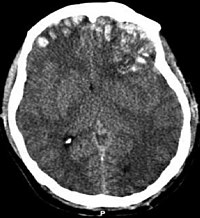
Photo from wikipedia
Supplemental Digital Content is available in the text Abstract The purpose of this study was to determine whether different types of position-related cranial deformities show changes after completion of head… Click to show full abstract
Supplemental Digital Content is available in the text Abstract The purpose of this study was to determine whether different types of position-related cranial deformities show changes after completion of head orthosis therapy. We investigated how children's age at the begin of molding helmet therapy affects the duration and long-term stability of treatment. In addition, parental satisfaction with helmet therapy has been investigated. Between 2012 and 2019, 47 patients have been analyzed after undergoing helmet therapy. At the beginning of treatment different disease pattern were classified. Posterior deformational Plagiocephalus defined by a cranial vault index (CVA) > 1 cm and a cranial index (CI) ≤ 90%. Posterior deformational Brachycephalus defined by CVA ≤ 1 cm and CI > 90%. Posterior deformational combined Plagio- and Brachycephalus defined by CVA > 1 cm and CI > 90%. At the beginning of therapy, the end of therapy and within 5-year-follow-up CI and CVA was measured by three-dimensional photogrammetry for 2 age groups (4–6 and 7–12 months). Additionally, parents completed a standardized questionnaire to evaluate the personal assessment of treatment outcome. During treatment CI and CVA of all children decreased significantly (P < 0.001). Furthermore, CI significantly decreased after ending helmet therapy (P < 0.001). Cranial vault index decreased not significantly in the same period (P = 0.361). For the 4 to 6 months old group treatment time was significantly shorter than for the older group. Before starting helmet therapy nearly half of the parents graded the scull as moderate and one-third as severe deformed. After ending treatment, the majority of parents report satisfaction and compliance. However, one-third of parents noted a slight scull deformation and personal load during therapy. After completion of therapy an improvement of head shape can be expected for the majority of children. This is particularly evident for improvement of the CI and a shorter treatment time until the age of 6 months at the beginning of therapy. Parents reported satisfaction and child compliance. Almost all parents were convinced that treatment was useful and would repeat it again.
Journal Title: Journal of Craniofacial Surgery
Year Published: 2021
Link to full text (if available)
Share on Social Media: Sign Up to like & get
recommendations!